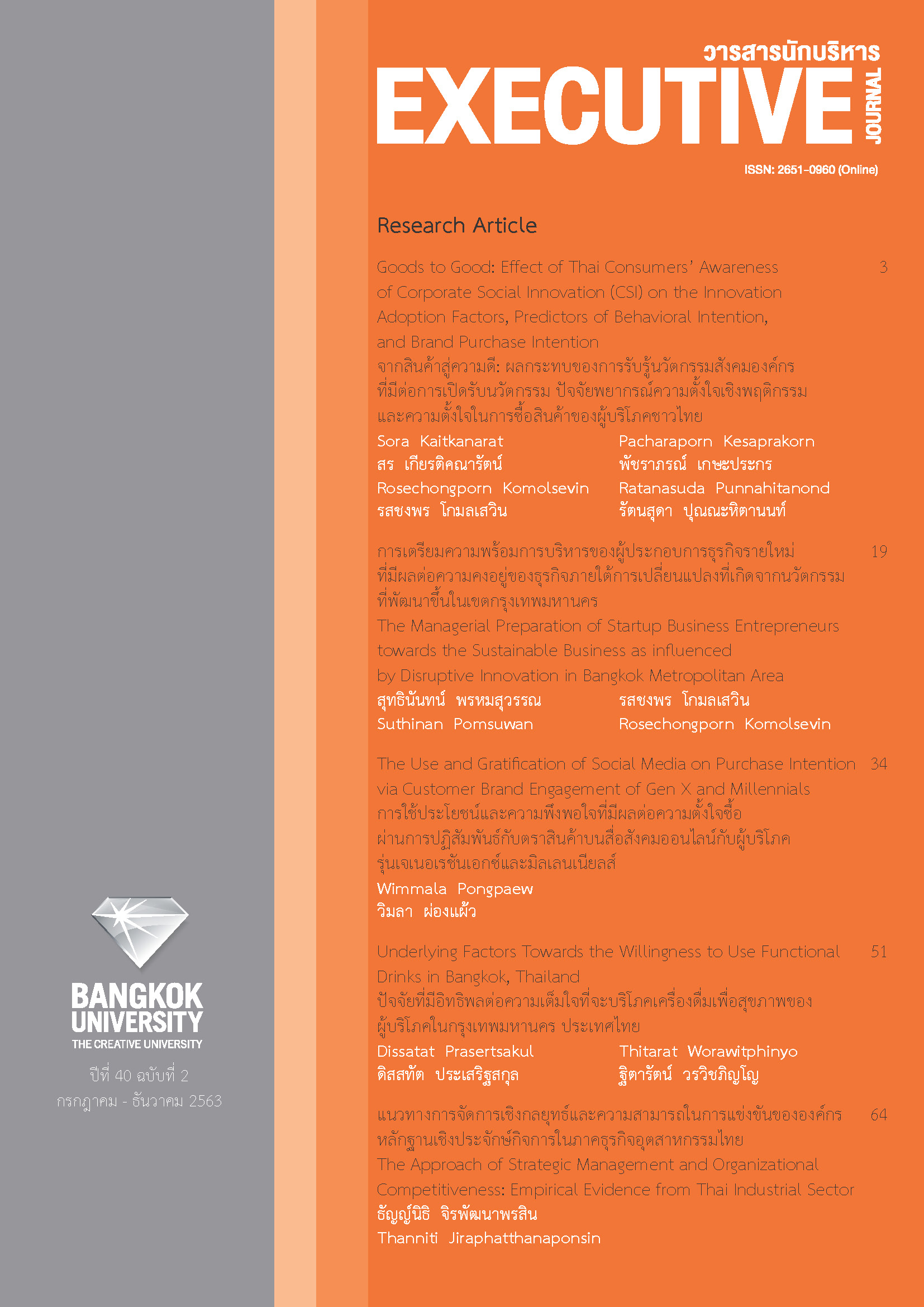แนวทางการจัดการเชิงกลยุทธ์และความสามารถในการแข่งขันขององค์กร หลักฐานเชิงประจักษ์กิจการในภาคธุรกิจอุตสาหกรรมไทย
Main Article Content
บทคัดย่อ
การศึกษาครั้งนี้มีวัตถุประสงค์ 1) เพื่อยืนยันองค์ประกอบการจัดการเชิงกลยุทธ์ และ 2) เพื่อศึกษา
การจัดการเชิงกลยุทธ์โดยรวมและรายด้านที่ส่งผลต่อความสามารถในการแข่งขันขององค์กร กลุ่มตัวอย่างที่ใช้ในการวิจัยในครั้งนี้ คือ กิจการในนิคมอุตสาหกรรมแห่งประเทศไทย จำนวน 212 กิจการ เลือกกลุ่มตัวอย่างโดยใช้การสุ่มแบบหลายขั้นตอน และผู้บริหารองค์กรและผู้บริหารฝ่ายบัญชีเป็นผู้ให้ข้อมูล สถิติที่ใช้ในการทดสอบสมมติฐาน ได้แก่ การวิเคราะห์สหสัมพันธ์ การวิเคราะห์องค์ประกอบเชิงยืนยัน และการวิเคราะห์การถดถอยพหุคูณ ผลการวิจัยพบว่า 1) องค์ประกอบของการจัดการเชิงกลยุทธ์ ประกอบด้วยกลยุทธ์ โครงสร้าง ระบบและวิธีปฏิบัติงาน การจัดคนเข้าทำงาน ทักษะ รูปแบบการทำงานของผู้บริหาร และค่านิยมร่วมขององค์กร และโมเดลมีความสอดคล้องกับข้อมูลเชิงประจักษ์ และ 2) การจัดการเชิงกลยุทธ์ส่งผลกระทบทางบวกต่อความสามารถในการแข่งขันขององค์กรอย่างมีนัยสำคัญทางสถิติที่ระดับ 0.05 เมื่อพิจารณาเป็นรายด้านพบว่า การจัดการเชิงกลยุทธ์ด้านระบบและวิธีปฏิบัติงาน และการจัดคนเข้าทำงานด้านรูปแบบการทำงานของผู้บริหาร ส่งผลทางบวกต่อความสามารถในการแข่งขันขององค์กรอย่างมีนัยสำคัญทางสถิติที่ระดับ 0.10
Article Details
บทความที่นำมาสมัครลงตีพิมพ์ในวารสารต้องไม่เคยได้รับการตีพิมพ์เผยแพร่มาก่อน และไม่ส่งต้นฉบับบทความซ้ำซ้อนกับวารสารอื่น รวมทั้งผู้เขียนบทความต้องไม่ละเมิดหรือคัดลอกผลงานของผู้อื่น
References
Armstrong, J. S., & Overton, T. S. (1977). Estimating nonresponse bias in mail surveys. Journal of Marketing Research, 14(3), 396-402.
Bartlett, C. A. (1996). McKinsey & company: Managing knowledge and learning. Boston, MA: Harvard Business School.
Buzatu, A. I., Pleșea, D. A., Iulian, C., & Valentin, W. P. (2019). Managing organizations for sustainable business development: Interaction between VRIO framework and Mckinsey 7s framework. In R. Pamfilie, V. Dinu, L. Tăchiciu, D. Pleșea, & C. Vasiliu, (Eds.), New trends in sustainable business and consumption 2019 (pp. 243-251). Bari: BASIQ.
Chubbs, K. M. (2020). Healthcare organizational design strategies to improve performance (Doctoral thesis, Walden University).
Fajartriyani, A. P., Raharja, S. J., Dai, R. M., & Hardinata, C. (2019). Strategic planning of Indonesian skincare clinics. Academy of Strategic Management Journal, 18(3), 1-16.
Farace, R. V., Monge, P. R., & Russell, H. M. (1977). Communicating and organizing (Vol. 1077). Reading. Mass, MA: Addison-Wesley.
Fayol, H. (1949). General and industrial management. London: Pitman.
Gulick, L. (1937). Science, values and public administration. In L. Gulick, & L. Urwick (Eds.), Papers on the science of administration (pp. 189-195). New York, NY: Institute of Public Administration.
Hair, J. F., Black, W. C., Babin, B. J., & Anderson, R. E. (2010). Multivariate data analysis (6th ed.). New Jersey, NJ: Pearson Education.
Hanafizadeh, P., & Ravasan, A. Z. (2011). A McKinsey 7S model-based framework for ERP readiness assessment. International Journal of Enterprise Information Systems, 7(4), 23-63.
Hofer, P., Eisl, C. & Mayr, A. (2012). Performance measurement in internet companies. Paper presented at the An Enterprise Odyssey: Corporate Governance and Public Policy —Path to Sustainable Future, Sibenik, Croatia.
Kaplan, R. S. (2005). How the balanced scorecard complements the McKinsey 7-S model. Strategy & Leadership, 33(3), 41-46.
Khunchuen, U. (2014). Khwāmsamphan rawāng kānčhatkān čhet ' s mǣkkhinsī kap phonlakā rō̜dam nœ̄n ngān khō̜ng thurakit nam dư̄m nai čhangwat Maha Sarakham [The relations of the McKinsey 7s management with drinking water business in Maha Sarakham province] (Master’s thesis, Rajabhat Maha Sarakham University).
Lata, P. (2020). The influences of participatory management and corporate governance on the reduction of financial information asymmetry: Evidence from Thailand. The Journal of Asian Finance, Economics and Business, 7(11), 853-866.
Lata, P., Boonlua, S., & Raksong, S. (2017). Kāntrūatsō̜p chœ̄ng pračhak mōdēn tām sathānakān khō̜ng konlayut rabop kān watphon kāndā nœ̄n ngān bǣp būranākān : lakthān čhāk bō̜risat čhotthabīan nai Talāt Laksap hǣng Prathēt Thai [An empirical investigation of a contingency model of integrated performance measurement system strategy: Evidence from Thai-listed firms]. RMUTT Global Business and Economics Review, 12(2), 47-68.
Lata, P., & Ussahawanitchakit, P. (2015). Management accounting system effectiveness and goal achievement: Evidence from automotive businesses in Thailand. The Business and Management Review, 7(1), 322-334.
Libenth, R. (2017). Application of McKinsey 7S model approach in effective monitoring of revenue collection in TRA: Case of Kinondoni municipality (Doctoral dissertation, The Open University of Tanzania).
McKinsey, J. C. C. (1952). Introduction to the theory of games. New York, NY: McGraw-Hill.
Mumbe, J. R., & Njuguna, R. (2019). Strategic management practices and performance of small and medium-sized enterprises in Kitui County, Kenya. Journal of Strategic Management, 3(2), 30-45.
Nikhong, N. (2017). Kānčhatkān chœ̄ngkon yut læ phontō̜pthǣn čhāk kānlongthun khō̜ng thurakit rōngrǣm nai phư̄nthī čhangwat song khlā [Strategic management and return on investment from hotel business in Songkhla provinces] (Independent study, Yala Rajabhat University).
Nitchayaphon, S. (2012). Kānčhatkān chœ̄ngkon yut læ phontō̜pthǣn čhāk kānlongthun khō̜ng thurakit rān thōrasap mư̄ thư̄ nai phư̄nthī sām čhangwat chāidǣn phāk tai (ya lā pattānī narāthiwāt) [Strategic management and return on investment of mobile phone Business in the three southern border provinces (Yala, Pattani, Narathiwas)] (Independent study, Yala Rajabhat University).
Njue, C. M., & Ongoto, H. K. (2018). Strategic management practices and change implementation in selected public universities in Kenya. International Academic Journal of Human Resource and Business Administration, 3(4), 124-149.
Nunnally, J. C., & Bernstein, I. H. (1994). Psychometric theory. New York, NY: McGraw-Hill.
Peters, T. J., & Waterman, R. H. (1982). In search of excellence: Lessons from America's best-run companies. New York, NY: Harper & Row.
Petkong, T. (2014). Khwāmsamphan rawāng kānbō̜rihān čhet ' S kap prasitthiphon kānbō̜rihān khwāmsīang tām khwāmkhithen khō̜ng khana kammakān læ čhaonāthī khō̜ng sahakō̜n ʻō̜m sap khrū nai klum čhangwat rō̜i kǣ sān sin [Relationship between the McKinsey 7s framework and the risk management effectiveness according to the opinions of the board and officers of teachers saving and credit cooperative in the Roikaensarasin Provincial group] (Master’s thesis, Rajabhat Maha Sarakham University).
Porter, M. E. (1985). Technology and competitive advantage. Journal of Business Strategy, 5(3), 60-75.
Putra, R. P., Syah, T. Y. R., Pusaka, S., & Indradewa, R. (2019). Human resources implementation using the McKinsey 7S method for business startup: Duck nugget frozen food. Journal of Multidisciplinary Academic, 3(3), 11-14.
Qehaja, A. B., Kutllovci, E., & Pula, J. S. (2017). Strategic management tools and techniques usage: A qualitative review. Acta Universitatis Agriculturae et Silviculturae Mendelianae Brunensis, 65(2), 585–600.
Rani, P. (2019). Strategy implementation in organizations: A conceptual overview. Management, 14(3), 205-218.
Ravanfar, M. M. (2015). Analyzing organizational structure based on 7s model of McKinsey. Global Journal of Management and Business Research, 15(10), 6-12.
Signori, A., & Vismara, S. (2018). Does success bring success? The post-offering lives of equity-crowdfunded firms. Journal of Corporate Finance, 50, 575–591.
Srivastava, R. M., & Verma, S. (2012). Strategic management: Concepts, skills and practices. New Delhi, ND: PHI Learning.
Taylor, F. W. (1914). Scientific management: Reply from Mr. FW Taylor. The Sociological Review, 7(3), 266-269.
Yamane, T. (1973). Statistics: An introductory analysis (3rd ed.). New York: Harper & Row.
Yitmen, T. (2011). Intellectual capital: A competitive asset for driving innovation in engineering design firms. Engineering Management Journal, 23(2), 1-16.

